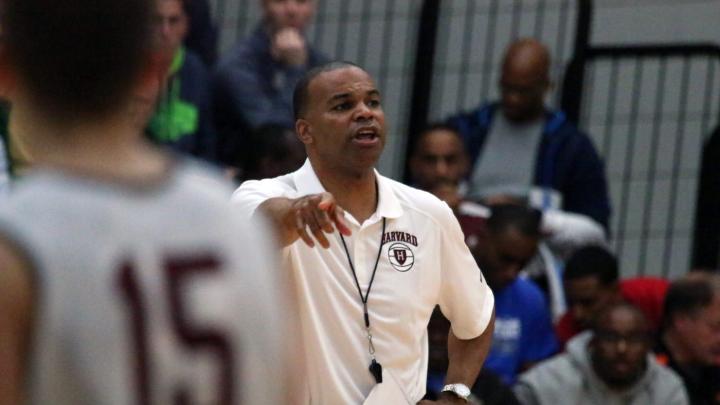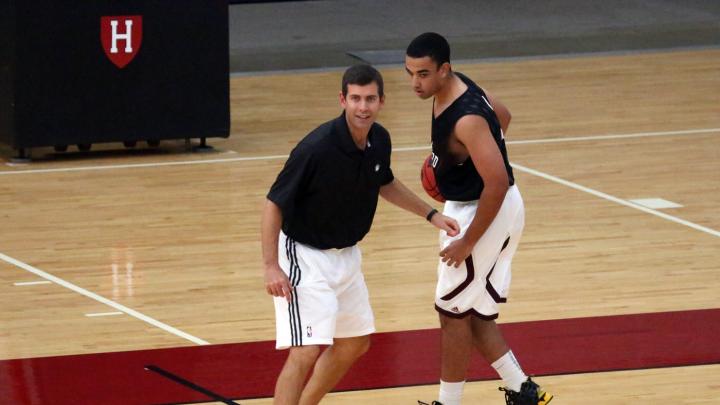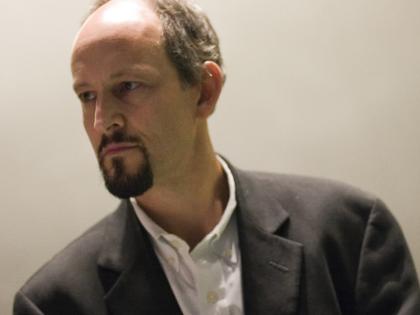Harvard Hardwood, the Harvard Magazine basketball report
The exchange began plainly enough. Shortly after noon on Saturday, October 25, an attendee at the Harvard men’s basketball coaching clinic asked Harvard head coach Tommy Amaker why he allows his post players to choose whether to turn to or away from the ball after setting a screen for a pick-and-roll, where one player sets a screen (“pick”) for the teammate with the ball and then turns (“rolls”) to the basket. The question captured a nuance in Amaker’s offense, but it also seemed unlikely that the fate of anyone’s season would hinge on Amaker’s response.
Yet as Amaker began to tell a story about a time his highly regarded college coach, Mike Krzyzewski, had put the “fear of God in [him],” the attendees leaned forward. Early in Amaker’s freshman year at Duke, Krzyzewski had halted practice and “blasted” him about why he did not have his palms up on defense. Unsure whether he was supposed to respond, Amaker politely explained that he had been taught to play defense with his palms down. To Amaker’s shock, Kryzweski told him that was OK.
From a purely basketball perspective, giving Amaker this discretion worked out well (he was named National Defensive Player of the Year as a senior). More important: the exchange made an indelible impression on the young point guard’s budding coaching philosophy. Amaker explained, “I really appreciated that as a freshman my coach trusted me enough to allow me to do something where I was a little more comfortable.” As a result, he now allows his players similar discretion, including letting his big men decide which way they want to turn after a pick-and-roll.
That a seemingly innocuous question could prompt such a thoughtful response encapsulates the educational significance of Amaker’s eighth annual coaching clinic, which was held at Lavietes Pavilion and featured two of the best basketball minds in the Boston area. During the morning, the 200-plus attendees—a group that consisted primarily of high-school and college coaches who paid to attend, as well as a handful of Harvard staff members and students whom the team admitted for free—witnessed Amaker lead the Harvard basketball team through a practice. In the process, they learned a little about how Amaker became the coach he is—and how he has transformed Harvard from an Ivy League doormat into a four-time league championship team that has won opening-round games in back-to-back NCAA tournaments. (For background on the team and the prospects for this season, read “From Crimson Madness to March Madness?”—the first Harvard Hardwood report.)
The second half of the event, featuring Boston Celtics head coach Brad Stevens, provided a tantalizing opportunity to look to the future. Before joining the Celtics in 2013, Stevens was the head coach at Butler University, another mid-major program (a team that plays outside the seven most prominent or “high-major” conferences); in 2010 and 2011, he led the Bulldogs to back-to-back appearances in the NCAA championship game. What can Amaker and Harvard glean from Stevens as they strive to pull off a similarly magical post-season run?
A Window into Amaker
Shortly after 11:00 a.m., Amaker thanked the attendees for coming and introduced the Harvard players, his three assistants, the team’s managers, and his guests, including several former Harvard players and Togo Palazzi, a Holy Cross star in the 1950s and former member of the Celtics. He reserved his warmest welcome for Paul “Red” Jenkins, his coach at W.T. Woodson High School in Fairfax, Virginia, who had taught him to play defense with his palms down and whom he called “one of the best teachers of the game of basketball” he has ever known.
Then the workout began. The first thing that impressed was the high level of organization and efficiency. The entire session—which lasted approximately 70 minutes—had been outlined in advance on a practice plan distributed to attendees: 17 activities, each lasting two to six minutes. Amaker positioned his assistants and managers around the gym to ensure that each station proceeded expeditiously; to save time, he had his players get water by class year. The audience began to see how the team has developed a reputation as one of the most disciplined squads in the league.
The practice also reflected the emphasis Amaker places on teamwork and communication. He began the session, as he always does, by offering a “thought of the day:” Saturday’s was “Do what you’re supposed to do before doing what you want to do.” He also highlighted this concept in specific drills. At one point, for example, he suggested that effective “help defense” hinges not on who provides the initial support, but instead on the entire team trusting that someone is always going to be willing to “help the helper.” And throughout practice, he demanded communication between, and clapping and encouragement for, teammates. Given this emphasis on teamwork, it’s unsurprising that last year Harvard boasted a balanced offensive attack in which all five starters scored in or close to double digits.
Yet if one were to encapsulate the workout in one word, it would be “pace.” Soon after practice started, Amaker told the clinic attendees that he and his staff taught his players to “sprint,” not just run, to offense and defense. Throughout the workout, he lauded players who sprinted and once halted practice to chide a player who did not. It is no coincidence that Harvard has become known as a tenacious man-to-man defensive squad and has such an able fast break; Amaker has built this capacity into the program’s DNA.
He concluded the practice with conditioning, as most coaches do, particularly during the preseason; the team had to complete 20 excellent possessions. By the end, the players were breathing hard, and Amaker, who at the crowd’s request had eschewed a microphone, was a tad hoarse. Clearly, at least one key ingredient of the team’s turnaround is simple: it has involved a great deal of hard work.
 Harvard Hardwood
Harvard Hardwood
Follow Harvard Magazine’s coverage of basketball
throughout the 2014-2015 season.
Sign up here for basketball updates via e-mail.
A Window into the Future
Following a question-and-answer session and a break for lunch, Celtics coach Brad Stevens took the floor. This gave Amaker and the Harvard players—who under NCAA rules cannot work out with a current NBA coach—a chance to take a break from (at least) the physical side of basketball. But during the next 90-plus minutes, as Stevens lectured about his coaching strategy and put the Harvard club team through several drills, Amaker and the varsity squad watched closely. They, too, were there to learn—and, in particular, hoped to pick up insights they could apply to their season.
In a handful of respects, Stevens’s approach seemed to differ from Amaker’s: most notably, the Celtics coach placed far greater emphasis on the merits of film study. But what was more apparent were the commonalities in their systems. Like Amaker, Stevens prizes tough defense, efficient and organized workouts, and pace. In fact, he is pushing his Celtics squad to get the ball over half-court in four seconds or less.
Curiously, if Amaker and the Harvard squad want more clues about how to make a Butler-like run in March, they might be better off studying a guest who accompanied Stevens to the clinic: Celtics assistant coach Ronald Nored. Nored, whom Amaker had tried to recruit to play for Harvard, was a star guard on both Butler teams that played in the national championship game. Stevens explained that Nored had thrived not because he was a superior talent but because he grew as a player and committed to the Butler system, particularly defensively.
This highlights the importance of player development. Unlike the country’s most established basketball programs (most notably Kentucky), mid-major teams like Harvard and Butler are unlikely to recruit a roster of top-flight players who will leave for the NBA after one or two years. Instead, they are apt to thrive by recruiting and teaching players who can flourish across four years. Jeremy Lin ’10 is a case in point. Recruited by Amaker’s predecessor, Frank Sullivan, Lin blossomed into an NBA prospect under the tutelage of Amaker and his staff. Fostering this kind of individual growth—and ensuring that it occurs in the context of the team’s identity—is crucial to sustained success in March and beyond.
Thinking Big
Yet the importance of player development is a reminder, not a revelation. If one were to take one lesson from both coaches, it would be the capacity to think big. Stevens emphasized that he does not set specific goals for his team because he fears that his players will settle once they have achieved them. Similarly, Amaker refuses to place a cap on the program’s prospects; he highlights instead that anything is possible at Harvard.
Just how much is possible this year remains to be seen, but on Saturday, Amaker dropped an encouraging hint. Shortly after sharing his anecdote about palm positioning on defense, another attendee asked him to identify his most memorable win at Harvard. The answer? “It’s coming up this year.”









